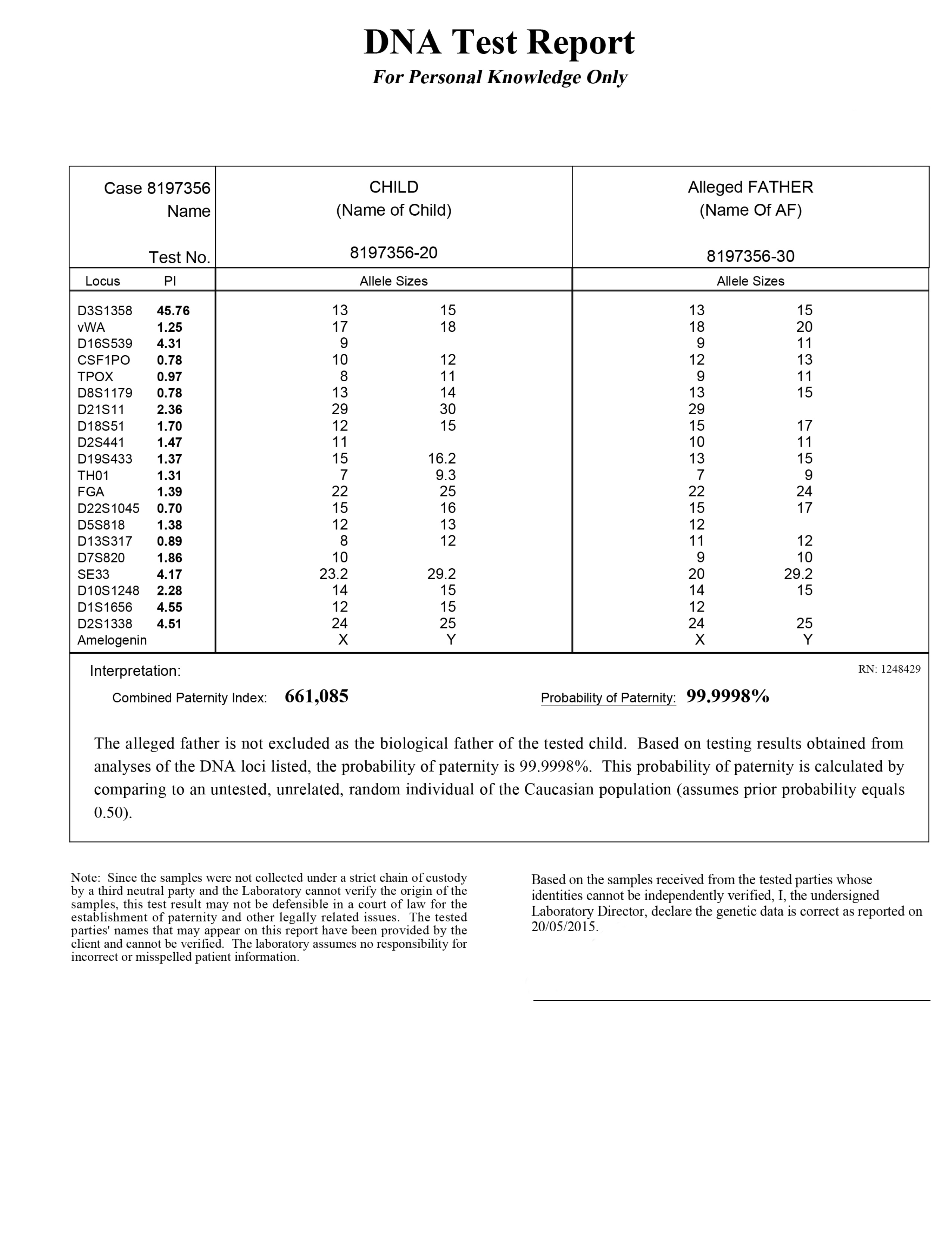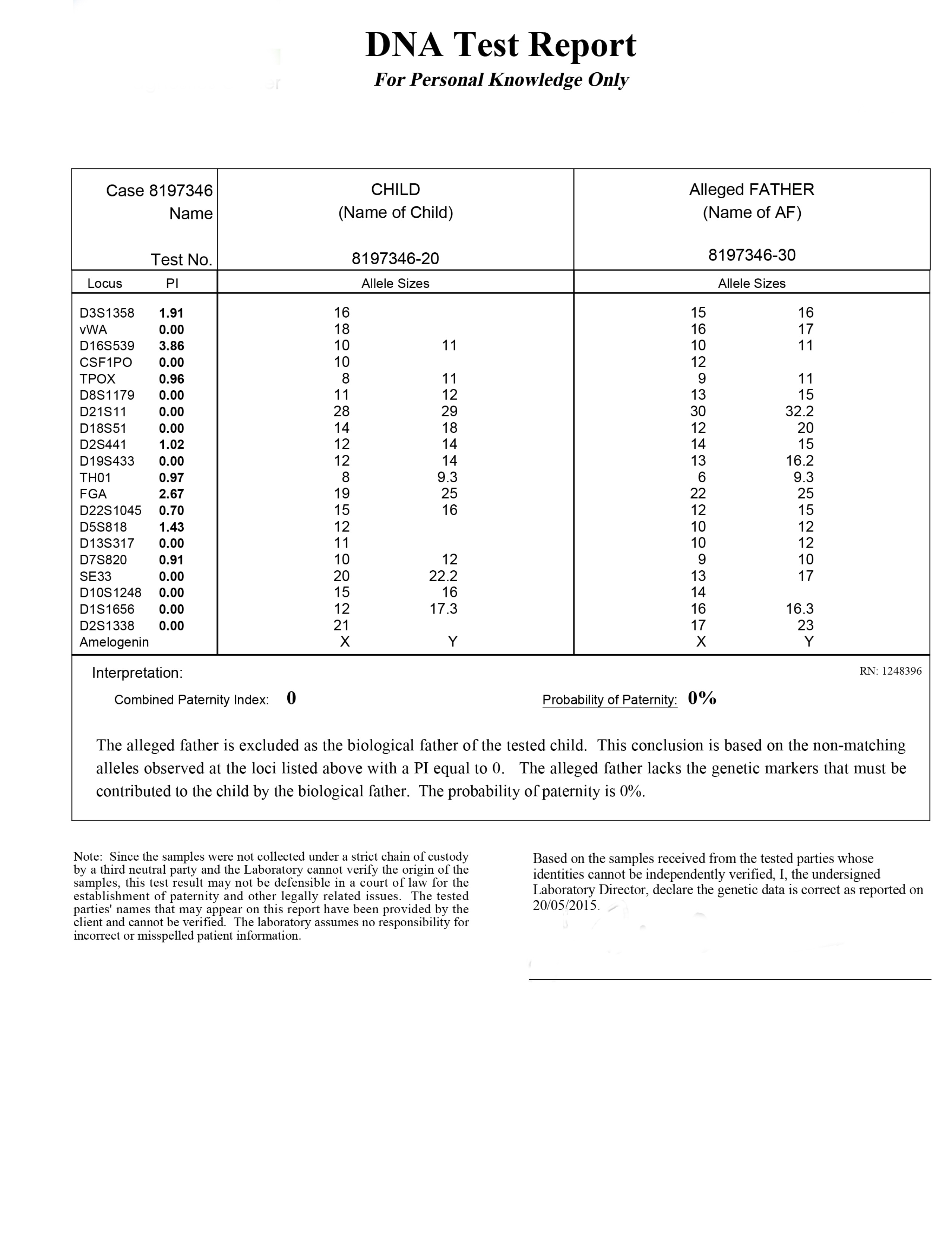Understanding your Test Results
The test report shows the results of laboratory DNA tests that provide evidence regarding the alleged family relationship. This is a brief explanation of the meaning of the numbers (that is to say, the statistical certainty of the result) and other items that appear in a DNA test report:
The laboratory analysis tests the DNA isolated from cheek swabs to locate certain regions of chromosomes that are known to vary in length between individuals. Twenty One of these sites are tested; each site is called a “locus”, (“loci” – plural). Analysis of these 21 sites in a large population has revealed many different sized versions associated with each site. Versions of a DNA sequence or a gene are called “alleles”. These are the genetic markers* used in parentage analysis.
Because each individual has two of each type of chromosome, one inherited from each parent, everyone has two alleles at each locus. These two alleles are sometimes identical (homozygous), but usually they are not the same size (heterozygous). During parentage testing, the laboratory identifies the length of the two alleles found at each locus.
The report you will receive shows numbers (in the first column) that indicate each of the 20 loci involved in the testing process and the 21st locus which is known as the amelogenin sex gene (by testing this gene we can establish whether the sample tested belongs to a male or female) .


The columns marked “allele” on the report contain numbers indicating the two alleles found at each locus (or one number if they are the same size).
If, for example, a child has two alleles that are designated 12.1 and 18, and if the mother has alleles 12.1 and 16, then the child inherited the 12.1 allele from the mother. The child has to have inherited the 18 allele from the father. The 18 allele is the “obligate paternal allele.” Generally, the alleged father must have this allele if he is the biological father of the child.
Fifteen different loci are used as genetic markers in the tests, as well as one (Amelogenin) to confirm the gender of the person providing the sample. If the alleged father does not have the matching allele at every tested locus, then he usually cannot be the biological parent. If he does have it, then he could be the father. A “relationship index” (called the “Direct Index” in the report) for each locus is calculated based on information including the portion of the male population that has the obligate paternal allele at that locus. This index is reported for each DNA locus.
A combined relationship (or “Direct”) index for all of the tested alleles is then calculated and appears below the chart. This number is used to calculate the “probability of relationship,” which is the percentage likelihood that a man with the alleles of the alleged father is the biological parent of the child, as compared to an untested, unrelated man of the same race. If the DNA of the alleged father is consistent (to a degree of mathematical certainty) with that of the child, then the report will conclude that the alleged father cannot be excluded as the biological father of the child. If the DNA is not consistent however, it will conclude that the alleged father can be excluded as the biological father of the child.
* Each locus used in the testing is composed of a variable number of repeating short sequences of the DNA building blocks or “bases”. These are referred to in short-hand as “A”, “C”, “T” and “G”. An example of a natural DNA sequence having such simple short repeats would be ACGACGACGACG, i.e. (ACG)4. However, each allele can have a different number of total repeats, for example (ACG)3 or (ACG)5 instead of (ACG)4, giving rise to a different fragment length when the DNA is purified and amplified in the test tube. In this example, (ACG)3, (ACG)4 and (ACG)5 would encode variant alleles with building block lengths of 3 x 3, 4 x 3, and 5 x 3, that is to say 9, 12, and 15 building block lengths. Since DNA analysis machines detect changes in length of just one unit, these differences in length are easily distinguished.








